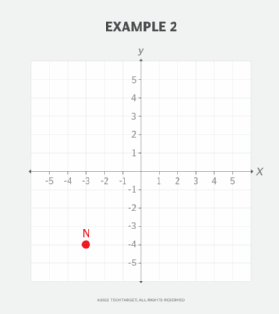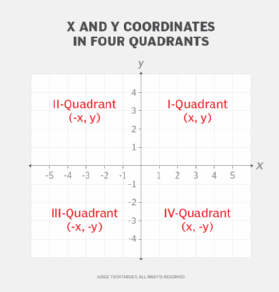x and y coordinates
What are x and y coordinates?
X and y coordinates are, respectively, the horizontal and vertical addresses of a point in any two-dimensional (2D) space, such as a sheet of paper or a computer display screen. Together, these coordinates help identify the exact location of a point.
In the Cartesian coordinate system, the x and y coordinates are part of the x-axis and y-axis in a 2D space. For a point in space, the x and y coordinates are written as an ordered pair, (x, y). The first number represents the point's position on the x-axis, and the second number represents its position on the y-axis. The coordinates can also be written as (x,y), without a space after the comma.

The order of the x and y coordinates in the ordered pair is important. The x coordinate always comes first, followed by the y coordinate. That is why (3, 4) is not the same as (4, 3).
(3, 4) refers to a point three units to the right of zero and four units above zero.
(4, 3) refers to a point four units to the right of zero and three units above zero.
The two axes intersect perpendicularly at the origin or zero location. The x and y coordinates of this location are written as (0, 0) or (0,0).
Important x and y coordinate terms
The x and y axes on which the x and y coordinates are plotted form a coordinate plane. The system was invented by French mathematician René Descartes and is known as the Cartesian coordinate system.
The coordinate plane is required to represent any point in a given 2D space. The plane, formed by the intersection of the two axes, is two-dimensional because the location of any point on this plane requires two data points:
- its distance on the x-axis
- its distance on the y-axis
These distances are represented by the x-coordinate and y-coordinate, respectively.
The x value of the point (x, y) is known as the abscissa. It represents the distance of the point from the origin or along the horizontal x-axis. The y value of the point (x, y) is known as the ordinate. It represents the vertical or perpendicular distance of the point from the origin or from the x-axis.
The point at which a line intercepts the x-axis is called the x-intercept, and the point at which it intercepts the y-axis is called the y-intercept. The y coordinate of an x-intercept is 0, and the x coordinate of a y-intercept is 0. If the equation of a line is available (y = mx + b), plugging in x = 0 into the equation yields the y-intercept. Similarly, plugging in y = 0 gives the x-intercept.
The coordinate plane is divided into four quadrants:
- Quadrant 1 is in the top right.
- Quadrant 2 is in the top left.
- Quadrant 3 is in the bottom left.
- Quadrant 4 is in the bottom right.
Representing x and y coordinates with examples
Any point in a 2D space is represented by x and y coordinates as an ordered pair, either of which can be zero, positive or negative.
If either value is zero, the point is represented as the following:
- (0, y): The x coordinate is zero, so the point lies on the y-axis.
- (0, 10): The point is on the y axis and 10 units above.
- (0, -10): The point is on the y axis and 10 units below.
- (x, 0): The y coordinate is zero, so the point lies on the x-axis.
- (10, 0): The point is on the x axis and 10 units to the right of zero.
- (-10, 0): The point is on the x axis and 10 units to the left of zero.
If both the x and y coordinates are zero (0, 0), the point is on the origin, which is where the x-axis and y-axis intersect.
If both x and y coordinates are non-zero, the point lies somewhere on the 2D coordinate plane in one of its four quadrants.

Example 1
Consider point M in the coordinate plane here.
M lies one unit to the right of zero and two units above zero. So, its x coordinate is (1), and its y coordinate is (2). Together, its (x, y) coordinates are represented on the 2D coordinate plane as the following:
M = (1, 2)
Point M is in Quadrant 1.

Example 2
Consider point N in the coordinate plane here.
N lies three units to the left of zero and four units below zero. So, its x coordinate is (-3), and its y coordinate is (-4). Together, its (x, y) coordinates are represented on the 2D coordinate plane as the following:
N = (-3, -4)
Point N is in Quadrant 3.
Positive and negative values in the 4 quadrants
Depending on the location of the point in one of the four quadrants on the coordinate plane, the x and y coordinates will have positive or negative values. If the x coordinate is in the left part of the plane, it has a negative value, and if it is in the right, its value is positive.
Similarly, if the y coordinate is on the top part of the plane, its value is positive. If it is in the bottom plane, it has a negative value. The left, right, top and bottom parts of the plane are determined by the location of the point from the origin or zero value.
| Quadrant | Point location | X value (positive/negative) |
Y value (positive/negative) |
(x, y) |
| Quadrant 1 |
Top right |
Positive |
Positive |
(+, +) |
| Quadrant 2 |
Top left |
Negative |
Positive |
(-, +) |
| Quadrant 3 |
Bottom left |
Negative |
Negative |
(-, -) |
| Quadrant 4 |
Bottom right |
Positive |
Negative |
(+, -) |
Example 1
(2, 5): The point is in Quadrant 1, two units to the right of zero and five units above zero.
Example 2
(-2, 5): The point is in Quadrant 2, two units to the left of zero and five units above zero.

Example 3
(-2, -5): The point is in Quadrant 3, two units to the left of zero and five units below zero.
Example 4
(2, -5): The point is in Quadrant 4, two units to the right of zero and five units below zero.
Uses of x and y coordinates
The x and y coordinates of a point are required to find the distance of that point from the declared origin of a 2D space. The coordinates are also used to find the midpoint and slope of a line and to determine its linear equation.
The linear equation of a line is represented as y = mx + b:
- m = slope = change in y / change in x
- x = x coordinate, "how far along"
- y = y coordinate, "how far up"
- b = value of y when x = 0
Here's what the (x, y) coordinate pair looks like if the value of x is known and if the equation is expressed as y = 2x + 2:
| X coordinate | Y coordinate | Slope (m) | y = 2x + 2 | (x, y) |
| 0 |
2 |
2 |
2 |
(0, 2) |
| 1 |
4 |
2 |
4 |
(1, 4) |
| 2 |
6 |
2 |
6 |
(2, 6) |
| 3 |
8 |
2 |
8 |
(3, 8) |
| 4 |
10 |
2 |
10 |
(4, 10) |
To graph the equation y = 2x + 2, each coordinate in each ordered pair is located on a coordinate grid. Then, the x and y coordinates are connected to form a straight line.
See also: mathematical symbols.
